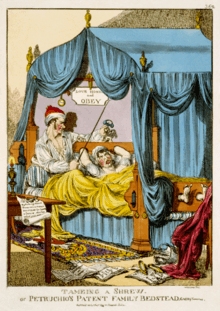Bianca Minola
| Bianca Minola | |
|---|---|
 Lenka Pichlíková as Bianca and Dagmar Veškrnová as Katharina in The Taming of the Shrew (Jiří Wolker's Theatre Prague) | |
| Creator | William Shakespeare |
| Play | The Taming of the Shrew |
| Date | c.1590-1594 |
| Source | Ludovico Ariosto's I Suppositi |
| Role |
Ingenue Baptista's younger daughter Kate's sister Lucentio's love |
| Portrayed by |
Linda Arvidson (silent, 1908) Dorothy Jordan (film, 1929) Natasha Pyne (film, 1967) Susan Penhaligon (TV, 1980) Laura Boccanera (Italian film, 2004) |
Bianca Minola is a character in Shakespeare's The Taming of the Shrew (c.1590–1594). She is the younger daughter of Baptista Minola and the sister of Kate, the "shrew" of the title. The lovely Bianca has several admirers in the play, but Baptista has refused to allow her to marry until his shrewish daughter Kate has found a husband. When Kate marries, Bianca is united with her lover, Lucentio. Theatrically, Bianca is the ingenue in Shrew and the female lead in the play's subplot.
Origin
The basic elements of the play are present in Don Juan Manuel's 14th-century Castilian tale of the "young man who married a very strong and fiery woman".[1] The play's subplot, involving the characters Bianca and Lucentio, derives from Ludovico Ariosto's I Suppositi, either directly or through George Gascoigne's English version Supposes (performed 1566, printed 1573).[2]
Role in the play
Bianca Minola is the younger daughter of Baptista Minola and sister to Katherina (Kate) Minola. Unlike Kate, Bianca is very obedient and sweet-tempered, causing her to have a good number of suitors. Her father however declares that none may marry Bianca until Kate is wed. Desperate to win Bianca's hand in marriage, one of her suitors Hortensio gets his friend Petruchio, who is willing enough, to marry Kate so that Bianca would be allowed to marry. Hortensio then attempts to woo her in the disguise of a tutor named Litio. Bianca however falls in love with another suitor, Lucentio (also in the guise of a tutor 'Cambio'). The pair are married and at the wedding feast, Petruchio suggests a contest between himself, Lucentio, and Hortensio: They each send for their wives, and whoever's wife responds the most obediently wins. Despite Lucentio's faith in her obedience, Bianca does not come when summoned, saying that she is too busy. When she is forcefully brought to Lucentio by Kate, Bianca insists that her husband was a fool to set store by her obedience.
Throughout the play, there is evidence of sibling rivalry between Bianca and Kate as Kate accuses Bianca of being their father's "treasure" and the one that he wishes to have married first. In one scene, Kate ties Bianca's hands and whips her, in an attempt to discover which of her suitors Bianca likes the best (Bianca however insists that she has yet to meet a suitor that she truly loves).
Performances
Linda Arvidson plays Bianca in the first screen version of the play directed by D.W. Griffith (1908). Dorothy Jordan plays Bianca in the first "talkie" film version of the play with Mary Pickford as Kate and Douglas Fairbanks as Petruchio. Natasha Pyne renders the role in the 1967 film starring Elizabeth Taylor as Kate and her then-husband Richard Burton as Petruchio. Susan Penhaligon appears as Bianca in the 1980 BBC television production directed by Jonathan Miller. Laura Boccanera plays Bianca in the most recent film version of the play, Kate - La bisbetica domata (2004) which was billed as the first-ever stop-animation movie made in Italy.[3]
In the modern movie version 10 Things I Hate About You, Bianca is played by Larisa Oleynik.[4] In the ABC Family television series 10 Things I Hate About You, Bianca is played by Meaghan Jette Martin.[5]
References
- ↑ ,Juan Manuel Libro de los ejemplos del conde Lucanor y de Patronio, Exemplo XXXVº - De lo que contesçió a un mançebo que casó con una muger muy fuerte et muy brava.
- ↑ F. E. Halliday, A Shakespeare Companion 1564–1964, Baltimore, Penguin, 1964; pp. 181, 483.
- ↑ IMDb: The Taming of the Shrew
- ↑ http://www.imdb.com/title/tt0147800/
- ↑ http://www.imdb.com/title/tt1321805/
